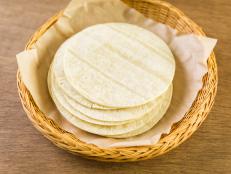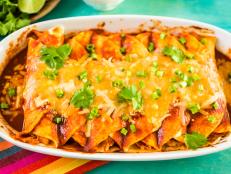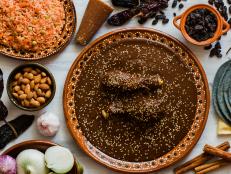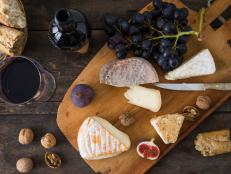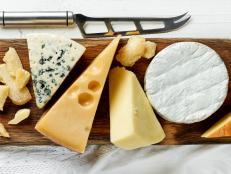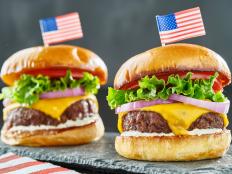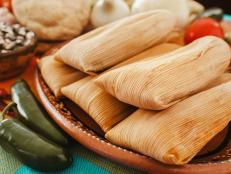How to Make Quesadillas
Learn how to make the toastiest, meltiest quesadillas at home, including how to choose the right tortillas, cheese and other ingredients.

Sapunovaphoto/Getty Images
By Carlos C. Olaechea for Food Network Kitchen
Quesadillas are a favorite dish at many Mexican and Tex-Mex restaurants, and for good reason. A crisp, lightly toasted tortilla that gives way to a flood of melted cheese once you take a bite is too good for most people to pass up. And the fact that you typically spruce up every bite with sauces, herbs, relishes and other condiments is just part of their appeal. In my book, a quesadilla is a perfect outlet for your culinary creativity, much like grilled cheese sandwiches. However, there are a couple tips to ensure that your quesadilla delivers the qualities we all love so much rather than a droopy, soggy mess. Below we dish out the secrets for how to make the best quesadillas at home.

4kodiak/Getty Images
What’s the Difference Between Corn Tortillas and Flour Tortillas?
Here’s a good rhyme to remember: without a tortilla, you can’t have a quesadilla. Tortillas are a type of unleavened flat bread native to Mexico and Central America. They can be made out of almost any type of flour, but the most common ones are made from either nixtamalized corn (corn that has been treated with mineral lime) or wheat flour. Deciding what tortilla to use depends on what texture you want and how much extra filling other than cheese you want to add to your quesadilla.
Corn Tortillas
Corn tortillas are the original tortillas and what the Mayas, Aztecs and other native people were eating before the arrival of Europeans to the Americas. Throughout most of Mexico, you’ll find quesadillas made with corn tortillas.
These quesadillas are usually smaller and crunchier than the ones made with flour tortillas. They can also stand up to more and wetter fillings without falling apart.
With most grocery store corn tortillas, you’ll have to make a little tortilla sandwich from two of them to make a quesadilla. This is in part due to their smaller size, but also because corn tortillas often crack when they’re folded. If you’re lucky enough to find a local tortilleria (a tortilla bakery), you may be able to fold one in half when it’s fresh off the comal (the traditional Mexican griddle).
Corn tortillas are also very diverse and come in many different colors from the common white to the sunset-colored yellow. Blue corn tortillas also have become much more available outside of Mexico, too, and they make really eye-catching quesadillas.
Flour Tortillas
Some people may think tortillas made from wheat flour are not really an authentic part of Mexican cuisine. However, flour tortillas reign supreme in Northern Mexico, which is where quesadillas are believed to have originated. Flour tortillas are also the most commonly available type of tortillas outside of Mexico, making them a quesadilla staple throughout the world.
There is a huge variety of flour tortillas available to purchase, including gluten-free and low-carb options. Almost all of them work equally well for quesadillas, although low-carb and gluten-free options may not crisp up as well as more traditional options.
Flour tortillas are flexible enough to fold over, unlike all but the freshest corn tortillas. However, there is only so much filling – especially wet filling – you can load up onto a flour tortilla before it becomes soggy and falls apart.

skhoward/Getty Images
How to Choose the Right Cheese for Your Quesadilla
You can use any kind of cheese you like to make a quesadilla, depending on the flavor and mouthfeel you want in the finished product. Typically, however, quesadillas contain mild, creamy cheeses that melt easily and are stretchy when warm.
Mozzarella cheese is perfect for quesadillas, widely available and actually very similar to many of the cheeses used in Mexico. A mild cheddar, Alpine-style cheese (like Swiss) or Gouda also work really well. Below are a few traditional suggestions, as well as which kinds of cheese to avoid.
Quesadilla Cheese
If you’re looking for cheese that was made for quesadillas, then this is it. Or, rather, quesadillas were made for this particular cheese. This is a mild, creamy, melty cheese from the state of Sinaloa in northwest Mexico. It’s also very popular in parts of Texas.
Quesadilla cheese is considered by many to be the original cheese used to make quesadillas. In fact, quesadillas are said to have gotten their name from this type of cheese, rather than the other way around. Quesadilla cheese is becoming increasingly available in the U.S. and features in many Mexican-style cheese blends sold at supermarkets.
Chihuahua Cheese
First off, Chihuahua cheese has nothing to do with the little dogs. It gets its name from the state of Chihuahua in northern Mexico along the borders, which shares a border with Texas and New Mexico. This cheese was traditionally made by German Mennonite immigrants, so people in Chihuahua refer to it as Mennonite cheese, while those throughout the rest of Mexico (and abroad) simply call it Chihuahua cheese. It has a flavor and texture similar to white cheddar or Monterey Jack.
Oaxaca Cheese
This cheese originated Oaxaca, a state in the southern part of Mexico famous for its food. The process for making mozzarella influenced how local Oaxacans made this cheese, so it shares many qualities with fresh mozzarella, especially its stretchiness. However, it isn’t as wet as its Italian equivalent, making it a better fit for quesadillas.
Oaxacan cheese is sold in ropes that are twisted or rolled together in balls, much like yarn. It is often referred to as Oaxacan or Mexican string cheese because you can pull it apart into tiny strings with your fingers, almost like an American cheese stick. In fact, this is the traditional way of shredding Oaxaca cheese for quesadillas.
Monterey Jack Cheese
This is an American original and is considered the gold standard with which to make traditional Tex-Mex and American-style quesadillas. It actually originated with Spanish monks in Monterey, California when that part of the United States belonged to Spain. Centuries later, an American man named David Jacks started to produce and sell it commercially, calling it Monterey Jack.
Nowadays, this has become the all-purposed “Mexican cheese” in the U.S. with a dizzying array of variations, like spicy pepper jack. It’s also combined with other American-style cheeses, like Colby. It is mild and stretchy and similar to Chihuahua cheese or white cheddar but a little creamier and not as greasy as melted cheddar.
Cheeses to Avoid
I used to think that if I loved to eat a cheese on its own, then it would be amazing melted in a sandwich, burger or quesadilla. However, that’s not always the case. Certain cheeses are meant to be melted, like the ones mentioned above. Others lose all their charm once they get near heat. And others become almost inedible.
Many people love to use sharp, aged cheddars in quesadillas, but that tangy bite and creamy texture disappear almost entirely once melted. Because much of the moisture has evaporated during the aging process, you don’t end up with a creamy, melty cheese. Rather, the milk solids and fats separate, leaving you with grease and something that tastes and feels like melted plastic.
Cheddar cheese can be wonderful in a quesadilla, but stick to younger, milder varieties and enjoy the older ones on their own. The same can be said with other harder, aged cheeses like Manchego and Parmesan.
On the other end of the spectrum are soft cheeses, like brie and Camembert, that turn liquid when heated and run all out the sides of the tortillas. You can make quesadillas with soft cheeses, but you need to be careful with the temperature and how long you toast your quesadilla to get the tortilla crispy and cheese gooey without it turning into a soggy, greasy catastrophe.

LauriPatterson/Getty Images
Other Ingredients to Add to Quesadillas
A cheese quesadilla is classic, but I always like to add some meat and/or veggies to my cheesy tortilla creations to make them more of a complete meal. You are only limited by your imagination when it comes to what you can add. However, you may want to avoid extras that are too wet, as this can lead to soggy quesadillas.
Veggies and Herbs
Vegetables won’t cook much when you add them to your quesadilla, so do the pre-cooking ahead of time. Pre-cook watery vegetables like bell peppers, mushrooms and eggplants. Drain, rinse and pat dry canned vegetables before adding to your quesadilla. Blanch or sauté hearty greens like kale. Delicate greens and fresh herbs can be added to the cheese or other fillings raw. Cilantro is a classic addition. If you like a more intense cilantro flavor, try its bold cousin, saw tooth coriander (also known as culantro in Latin America). Dried or fresh oregano can also enhance the flavor of your quesadilla.
Meats
Grilled or pan-fried meats are best to add a meaty flavor to your quesadillas without making them soggy. You can also poach or braise chicken, pork, beef or any other meat and shred it before adding to your quesadilla. Try to avoid adding saucy stews, unless you are using thicker corn tortillas. Too much sauce will make flour tortillas fall apart, even if there is a layer of cheese between the sauce and tortilla. If you do want to fill your quesadilla with stewed meat, make sure to drain it from the sauce so that only a little bit of sauce coats the meat. This way you will get the flavor and just a touch of moisture in your quesadilla without it getting wet.
Seasonings
A touch of extra seasoning on your fillings or even just your cheese can take your quesadilla from just tasty to a flavor explosion with each bite. This can also help to boost the flavor of some milder cheeses, like mozzarella or Oaxaca cheeses. Here are some great suggestions to jazz up your quesadilla:
- Chili powder
- Adobo seasoning
- Complete Seasoning (Sazon Completo)
- Cayenne pepper
- Chili flakes
- Ground cumin
- Curry powder
- Lemon pepper seasoning
- Ranch seasoning
How to Toast Quesadillas
There are several ways to toast a quesadilla. Traditionally, quesadillas in Northern Mexico and the United States are toasted on a comal or flat griddle. Some varieties in other parts of Mexico are made with corn tortillas and fried in abundant oil.
Should you heat quesadillas in oil?
The answer to this question depends in part on what type of tortilla you’re using.
When using corn tortillas, you should always toast them in oil. Corn tortillas cooked without oil can turn tough and leathery. Add enough oil to completely cover the bottom of the pan and fry them for golden results – they’ll crisp up or become crunchy depending on how long you cook them.
If you’re making quesadillas with flour tortillas, there are two schools of thought on whether or not you need to add oil.
Those in favor of toasting flour tortillas in oil note that it helps the quesadilla crisp up more evenly, puff up slightly, get just a little bit flakey and take on a richer flavor. Unless you’re using a non-stick pan, the extra lubrication from the oil will make it easier to flip your quesadilla and remove it from the pan or press when it’s done. Most recipes, in fact, call for adding butter or oil to a frying pan and then adding either a tortilla or a pre-assembled quesadilla. Alternatively, you can also brush the tortilla with melted butter, oil or even lard before toasting – a particularly useful tip when using an oven or press.
However, I stand by my preference for no oil. My reasoning: the cheese is rich enough on its own, as are the toppings I like to slather my quesadilla with - a lot of sour cream, Mexican crema or Honduran mantequilla and dollops of guacamole. Moreover, toasting without oil imparts a slightly smoky flavor to the quesadilla as if it were grilled. In my opinion, this unique flavor pairs better with cheese and other fillings than rich, buttery flavor.

Juanmonino/Getty Images
How to Make Quesadillas On the Stovetop
Benefits: This versatile technique is great for cooking flour or corn tortillas.
Equipment: You can use any type of cookware you like as long as it’s flat and large enough to toast your quesadilla evenly. A non-stick pan works really well for this because you’ll be cooking over medium low heat in order to achieve a toasted tortilla at the same time the cheese melts.
- Add oil to your skillet if you’d like and heat over medium low – or heat a dry skillet over medium low.
- Add the tortilla to the pan.
- Add a layer of cheese over half of a flour tortilla or over the entire surface of a corn tortilla. Add a thin layer of other ingredients of your choice and top with another layer of cheese.
- Fold the empty side of your flour tortilla over the loaded side. Or top your corn tortilla with a second one.
- Toast the quesadilla for a few minutes and flip it with a large spatula.
- If you see that one side isn’t as toasted as you like, flip it over and continue the process until the cheese is melted and the tortilla is toasted to your liking (I prefer some dark brown spots).

_jure/Getty Images
How to Make Quesadillas In the Oven
Benefits: This hands-off technique allows you to focus on making salsa or sides instead of watching the stove. You can also cook more quesadillas all at once. It’s best for cooking flour tortillas.
Equipment: All you’ll need is one or several baking sheets lined with parchment paper and an oven.
- Heat your oven to 350 to 400 degrees F.
- Assemble your quesadillas on the baking sheet by adding a layer of cheese over half a flour tortilla, topping it with a thin layer of ingredients of your choice and a second layer of cheese. Fold the empty side of your flour tortilla over the loaded side.
- Bake until the tortillas are golden brown and the cheese is melted, 5 to 10 minutes.

MSPhotographic/Getty Images
How to Make Quesadillas On a Press
Benefits: This method yields extra toasted, crispy quesadillas. That’s because most panini presses and waffle irons contain bumps and ridges. When toasting a quesadilla using one of these, the tortilla bends and curves to fill the groves in the press, resulting in more toasty bits per square inch of tortilla than simply toasting a quesadilla on a flat surface. Flour tortillas work best because they’re the most flexible.
Equipment: You will need a panini press or a waffle iron and pastry brush.
- Preheat your waffle iron or panini press to medium high.
- Brush one side of the tortilla with oil and place that side down on your worksurface. Add a thin layer of toppings to half the tortilla, leaving a 1-inch perimeter with no toppings (otherwise the fillings will squirt out into the press). Fold the empty half of the tortilla over the toppings.
- Place the quesadilla in the press, close the press gently (don’t push down) and cook until the tortilla is golden brown and the cheese is melted, about 5 minutes.
Related Links:
























